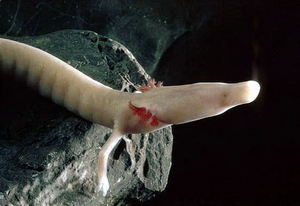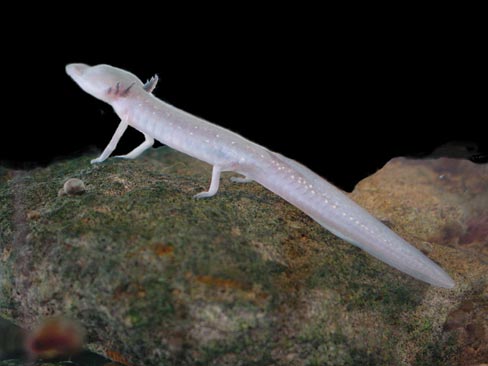Cave salamander on:
[Wikipedia]
[Google]
[Amazon]
 A cave salamander is a type of
A cave salamander is a type of


 *The following species have commonly been termed "the cave salamander" without any additional modifier or adjective:
**The
*The following species have commonly been termed "the cave salamander" without any additional modifier or adjective:
**The
 A cave salamander is a type of
A cave salamander is a type of salamander
Salamanders are a group of amphibians typically characterized by their lizard-like appearance, with slender bodies, blunt snouts, short limbs projecting at right angles to the body, and the presence of a tail in both larvae and adults. All t ...
that primarily or exclusively inhabits cave
A cave or cavern is a natural void in the ground, specifically a space large enough for a human to enter. Caves often form by the weathering of rock and often extend deep underground. The word ''cave'' can refer to smaller openings such as sea ...
s, a group that includes several species. Some of these animals have developed special, even extreme, adaptations to their subterranean environments. Some species have only rudimentary (or even absent) eyes (''blind salamanders''). Others lack pigmentation, rendering them a pale yellowish or pinkish color (e.g., ''Eurycea rathbuni
The Texas blind salamander (''Eurycea rathbuni'') is a rare cave-dwelling troglobite amphibian native to San Marcos, Hays County, Texas, specifically the San Marcos Pool of the Edwards Aquifer.
Description
The species has a broad, flat, snout ...
'').
With the notable exception of ''Proteus anguinus
The olm or proteus (''Proteus anguinus'') is an aquatic salamander in the family Proteidae, the only exclusively cave-dwelling chordate species found in Europe. In contrast to most amphibians, it is entirely aquatic, eating, sleeping, and br ...
'', all "cave salamanders" are members of the family Plethodontidae
Plethodontidae, or lungless salamanders, are a family of salamanders. Most species are native to the Western Hemisphere, from British Columbia to Brazil, although a few species are found in Sardinia, Europe south of the Alps, and South Korea. In ...
("lungless salamanders").
History
The first dedicated scientific study of a cave animal was focused upon a cave salamander, ''Proteus anguinus
The olm or proteus (''Proteus anguinus'') is an aquatic salamander in the family Proteidae, the only exclusively cave-dwelling chordate species found in Europe. In contrast to most amphibians, it is entirely aquatic, eating, sleeping, and br ...
''. It was originally identified as a "dragon's larva" by Johann Weikhard von Valvasor
Johann Weikhard Freiherr von Valvasor or Johann Weichard Freiherr von Valvasor ( sl, Janez Vajkard Valvasor, ) or simply Valvasor (baptised on 28 May 1641 – September or October 1693) was a natural historian and polymath from Carniola, pr ...
in 1689. Later, the Austrian naturalist Joseph Nicolaus Lorenz described it scientifically in 1768.
Another early scientific description of a cave salamander was undertaken by Constantine Samuel Rafinesque in 1822 while he was a professor of botany and natural history at Transylvania University
Transylvania University is a private university in Lexington, Kentucky. It was founded in 1780 and was the first university in Kentucky. It offers 46 major programs, as well as dual-degree engineering programs, and is accredited by the Southern ...
in Lexington, Kentucky. The species he described was known to the locals as a "cave puppet" and is now known to be ''Eurycea lucifuga
The spotted-tail salamander (''Eurycea lucifuga''), also known as a "cave salamander", is a species of brook salamander.
Description
The spotted-tail salamander is a relatively large lungless salamander, ranging in total length from 10 to 20&nb ...
''. His discovery was not surprising at the time because ''E. lucifuga'' inhabits near the entrance of caves, thus an in-depth exploration was not required; and, ''E. lucifuga'' is neither blind nor depigmented.
List of cave salamanders


 *The following species have commonly been termed "the cave salamander" without any additional modifier or adjective:
**The
*The following species have commonly been termed "the cave salamander" without any additional modifier or adjective:
**The olm
The olm or proteus (''Proteus anguinus'') is an aquatic salamander in the family Proteidae, the only exclusively cave-dwelling chordate species found in Europe. In contrast to most amphibians, it is entirely aquatic, eating, sleeping, and br ...
(''Proteus anguinus'', or proteus), the first discovered example, a blind salamander endemic to caves of southeastern Europe
**The spotted-tail cave salamander (''Eurycea lucifuga
The spotted-tail salamander (''Eurycea lucifuga''), also known as a "cave salamander", is a species of brook salamander.
Description
The spotted-tail salamander is a relatively large lungless salamander, ranging in total length from 10 to 20&nb ...
''), a lungless salamander endemic to caves of the eastern United States
*'' Eurycea'' (of North America) and ''Speleomantes
''Speleomantes'', or European cave salamanders, are a genus of salamander in the family Plethodontidae, or lungless salamanders. It is one of two genera in the family to inhabit the Old World (the other being '' Karsenia''), with the remaining ...
'' (of Italy and France) are two genera of lungless salamanders with so many individual species termed "cave salamanders" that the entire group is sometimes so designated.
*Individual species of "cave salamander" (in some cases "blind salamander"), usually designated with an additional modifier or adjective in their common name, include the following lungless salamanders:
**''Eurycea lucifuga
The spotted-tail salamander (''Eurycea lucifuga''), also known as a "cave salamander", is a species of brook salamander.
Description
The spotted-tail salamander is a relatively large lungless salamander, ranging in total length from 10 to 20&nb ...
'', often simply known as the cave salamander, alternately the spotted-tail salamander
**''Eurycea rathbuni
The Texas blind salamander (''Eurycea rathbuni'') is a rare cave-dwelling troglobite amphibian native to San Marcos, Hays County, Texas, specifically the San Marcos Pool of the Edwards Aquifer.
Description
The species has a broad, flat, snout ...
'', the Texas cave salamander, or Texas blind salamander (formerly, ''Typhlomolge rathbuni'')
**'' Eurycea tridentifera'', the Honey Creek Cave blind salamander, or Comal blind salamander
**'' Eurycea braggi'', the southern grotto salamander (formerly ''Typhlotriton braggi'')
**'' Eurycea nerea'', the northern grotto salamander (formerly ''Typhlotriton nereus'')
**''Eurycea spelaea
The western grotto salamander (''Eurycea spelaea''), also called the Ozark blind salamander and previously known as just the grotto salamander, is a species of salamander in the family Plethodontidae. It is endemic to the United States.
Its natur ...
'', the western grotto salamander or Ozark blind salamander (formerly, ''Typhlotriton speleus'')
**'' Speleomantes ambrosii'', Ambrosi's cave salamander, or French cave salamander, or Spezia cave salamander
**''Speleomantes imperialis
The imperial cave salamander, imperial salamander, odorous cave salamander, or scented cave salamander (''Speleomantes imperialis'') is a species of salamander in the family Plethodontidae. It is endemic to Sardinia.
Habitat and conservation
'' ...
'', imperial cave salamander, or scented cave salamander
**''Speleomantes supramontis
The Supramonte cave salamander (''Speleomantes supramontis'') is a species of salamander in the family Plethodontidae, endemic to the island of Sardinia (Italy).
Its natural habitats are temperate forests, rocky areas, caves, and subterranean h ...
'', the Supramonte cave salamander
**'' Speleomantes italicus'', the Italian cave salamander
**'' Speleomantes flavus'', the Monte Albo cave salamander, or Stefani's salamander
**''Speleomantes strinatii
''Speleomantes strinatii'', the French cave salamander, North-west Italian cave salamander, or Strinati's cave salamander is a small (10-12.5 cm long) species of salamander found in northwest Italy and southeast France. It is very similar in ...
'', Strinati's cave salamander
**''Speleomantes sarrabusensis
The Sarrabus' cave salamander or Sette Fratelli cave salamander (''Speleomantes sarrabusensis'') or, is a species of salamander in the family Plethodontidae. It is found in southeastern Sardinia, east of Cagliari
Cagliari (, also , , ; sc, ...
'', Sarrabus' cave salamander
**''Gyrinophilus palleucus
The Tennessee cave salamander (''Gyrinophilus palleucus'') is a species of salamander in the family Plethodontidae, endemic to the Appalachian Mountains in the United States. Its natural habitats are streams in caves. It is threatened by habitat ...
'', the Tennessee cave salamander
***'' G. p. necturoides'', the Big Mouth Cave salamander
**'' Gyrinophilus gulolineatus'', the Berry Cave salamander
**'' Atylodes genei'', the brown cave salamander, or Gene's cave salamander, Sardinian cave salamander, or simply Sardinian salamander
**'' Chiropterotriton mosaueri'', the cave splayfoot salamander
**'' Haideotriton wallacei'', the Georgia blind salamander (''Haideotriton'' is considered synonymous with '' Eurycea'' by some experts.)
**''Plethodon dixi
The Dixie Cavern salamander (''Plethodon dixi'') is a species of salamander in the family Plethodontidae. It is endemic to the state of Virginia in the United States. It is most often found in Roanoke County
Roanoke County ( ) is a county lo ...
'', the Dixie Caverns salamander
References
{{reflistSee also
*List of troglobites
A troglobite (or, formally, troglobiont) is an animal species, or population of a species, strictly bound to underground habitats, such as caves. These are separate from species that mainly live in above-ground habitats but are also able to live u ...
Amphibian common names